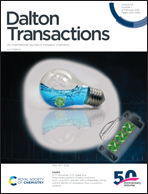On the CN−⋯K coordination modes in Kn[M6−n(CN)6]·xH2O: first evidence of CN−⋯K electron-deficient bonding†
Abstract
Based on the determination of single crystal XRD structures of potassium hexacyanidometallates and on IR, and Raman data, here we propose for the first time the occurrence of an electron-deficient bonding between the N end of the CN− ligand and the K+ metal center. The crystal structures of Kn[M6−n(CN)6]·xH2O (M = Fe(II), Ru(II), Os(II), Co(III), Rh(III), Ir(III), Pt(IV)) reveal the presence of four types of CN−⋯K interactions: (i) a linear CN–K bond, (ii) the N ends in a bipodal coordination involving two K atoms, (iii) the N ends in a tripodal coordination mode involving three K atoms and (iv) the N ends and the K atoms with the largest K–N distances within the subseries that can be attributed to the electrostatic interactions. The bi- and tripodal coordination modes between the N end of the CN− ligand and K+ ions are atypical and their nature is discussed in this contribution. The CN− ligand N end can behave as a two-electron donor that participates in a three-center two-electron bonding (i.e. Class II μ-L 3c–2e) for a N-bipodal coordination mode or as a two-electron donor that participates in a four-center two-electron bonding (4c–2e) for an N-tripodal coordination mode. Such a possibility is closely related to the π-back donation ability of the CN− ligand, which results in a charge density accumulation on the N end, which could be partially donated to the K atom through an σ-mechanism. For the divalent metals (Fe, Ru, Os), the solids crystallize with a monoclinic unit cell in the C2/c space group, while for the trivalent ones (Co, Rh, Ir), the crystal structure corresponds to an orthorhombic unit cell in the Pbcn space group. Potassium hexacyanidoplatinate(IV) crystallizes with a trigonal unit cell, in the P![[3 with combining macron]](https://www.rsc.org/images/entities/char_0033_0304.gif) 1m space group, where each N end is always found coordinating two K atoms. The finding of these novel coordination modes of the CN− ligands, relying on an electron-deficient bonding behavior, paves the way for the design of functional materials based on hexacyanidometallates. The experimental results and the proposed electron-deficient bonding model herein discussed were appropriately supported by the computational calculations.
1m space group, where each N end is always found coordinating two K atoms. The finding of these novel coordination modes of the CN− ligands, relying on an electron-deficient bonding behavior, paves the way for the design of functional materials based on hexacyanidometallates. The experimental results and the proposed electron-deficient bonding model herein discussed were appropriately supported by the computational calculations.
![Graphical abstract: On the CN−⋯K coordination modes in Kn[M6−n(CN)6]·xH2O: first evidence of CN−⋯K electron-deficient bonding](/en/Image/Get?imageInfo.ImageType=GA&imageInfo.ImageIdentifier.ManuscriptID=D0DT04019C&imageInfo.ImageIdentifier.Year=2021)


 Please wait while we load your content...
Please wait while we load your content...